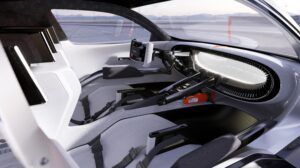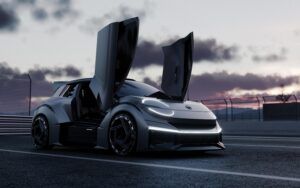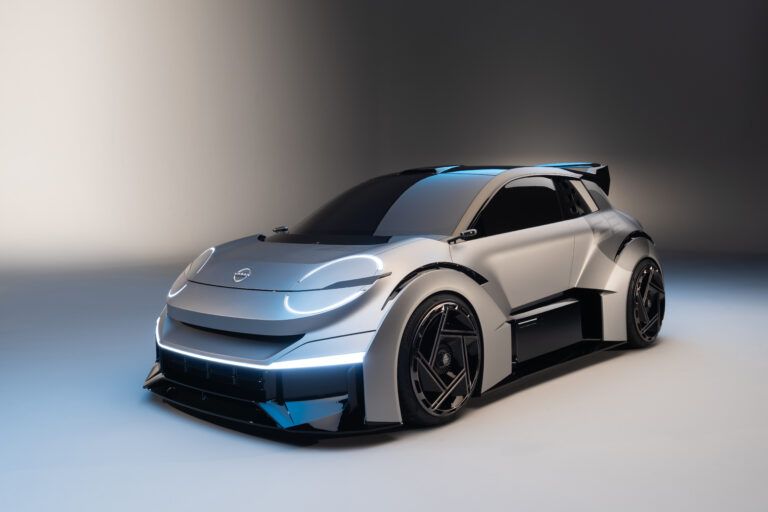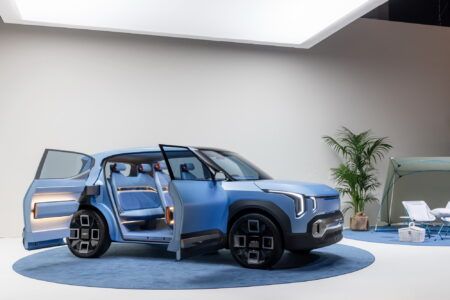With a population of over nine million, London is a city well used to containing a variety of different ideas, ideologies, and opinions, many of them opposing. This was brought into sharp relief back in September 2023 when the UK’s Prime Minister, Rishi Sunak, announced a major U-turn on his government’s climate commitments, including pushing back the deadline for selling new petrol and diesel cars. A few days later and three miles away from Downing Street where Sunak held his press conference, Nissan President and CEO Makoto Uchida stated his company’s intention to fulfil their commitment to achieving carbon neutrality by making the switch to full electric in Europe by 2030. “EV is the ultimate mobility solution,” said Uchida. “There is no turning back now,” he said.
Uchida was in the UK to celebrate the 20th anniversary of Nissan Design Europe (NDE) being in London, and to unveil an all-new sporty urban electric concept car called Nissan Concept 20-23. Based on the Paddington Basin stretch of the Grand Union canal, NDE’s 60-strong team has been responsible for many key cars for the Japanese automotive brand, including two generations of the Qashqai, the Juke and NV200 van, plus radical concepts for Nissan and its upmarket sister brand Infiniti. The unveil of the new Concept 20-23 took place on a floating barge moored directly outside NDE showing why the unique landscape around NDE makes it such a distinctive and inspiring location. The concept was designed by a team including some the younger members of NDE, with the simple brief to design a car – with no constraints – which would reflect the streets of the city where they work. The Concept 20-23 name reflects 20 years of NDE’s position in the heart of London, as well as the company’s traditional number 2 (ni) 3 (san) and the current year. It also continues a long Nissan tradition of bringing eye-catching playfulness to the world of hatchbacks and city cars. With the heritage of Nissan’s so-called Pike cars, such as the Be-1, Pao, Figaro and S-Cargo, Concept 20-23 brings a 21st century twist to this small-car tradition.
 “The young team here at NDE was given a simple brief: design a fun electric city car that you’d like to drive every day in London,” said Alfonso Albaisa, Nissan’s Senior Vice President for global design. “The 20-23 Concept that they designed is a compact hatchback which is strongly influenced by the online racing world.”
“The young team here at NDE was given a simple brief: design a fun electric city car that you’d like to drive every day in London,” said Alfonso Albaisa, Nissan’s Senior Vice President for global design. “The 20-23 Concept that they designed is a compact hatchback which is strongly influenced by the online racing world.”
The modern twist reflects both the world of online racing and Nissan’s participation in Formula E. The Concept 20-23’s basic 3-door hatchback body-style features extreme aerodynamic addenda front and rear, with deep skirts which direct the airflow away from the front of the car, through apertures to cool the brakes and out through vents just behind the front wheels. The nose of the car consists of a flat plane from which angles up to the top of the hood, giving the front an unexpectedly clean surface. This is where the front headlights are positioned, with their distinctive appearance consisting of a thin upper and lower semi-circle and enhanced by a sharp beam thanks to LED technology. The turn signal is part of the same semi-circle LED unit and gives the front of the Concept 20-23 a friendly appearance, in among the complex shapes which govern the airflow.
From the side, extended wheel arches shroud large wheels with low profile tyres. The top side of the wheel arches front and rear feature vented louvres to reduce the pressure that can create air resistance in the wheel bay. The curvature of the wheel arches finishes abruptly at the level of the lower door where angular intersections frame the air outlet behind the front wheel. And the same angular slits on the rear wheel arches allow the airflow to cool the rear brakes. The extended skirts hug the body side on the lower portion of the car.
At the rear, a large single-piece spoiler emerges from the roof rail, with endplates which curve from the near vertical close to the c-pillar over to the angled horizontal element which generates the downforce. Like the front, each of the rear lights consist of a thin upper and lower semi-circle LED which contrast with the squared off forms of the lower portion which is defined by fiercely functional shapes to manage the airflow and to maximise the creation of downforce as the air escapes from under the car. The full width of the car is emphasised by a horizontal bar below what looks like a soft smile that defines the outline of rear hatchback.
The exterior grey paint has a textured finish, giving the impression of being hewn from a single piece of metal. It also reflects the gritty, urban environment the car was designed to inhabit. The company number – 23 – features on the car’s rear three-quarters.
 While the Concept 20-23 car model is an exterior model only, the team of interior designers created an interior that reflects the extremely sporty nature of the exterior. Firstly, entry is by two scissor doors which hinge upwards from the base of the A-pillar. A brace bar runs across the door openings covered in foam padding to protect elbows, requiring the driver and passenger to step over it to reach their seats. The two deep bucket seats offer tight support, and are trimmed in a near-white finish, with a large head-support reminiscent of racing cars.
While the Concept 20-23 car model is an exterior model only, the team of interior designers created an interior that reflects the extremely sporty nature of the exterior. Firstly, entry is by two scissor doors which hinge upwards from the base of the A-pillar. A brace bar runs across the door openings covered in foam padding to protect elbows, requiring the driver and passenger to step over it to reach their seats. The two deep bucket seats offer tight support, and are trimmed in a near-white finish, with a large head-support reminiscent of racing cars.
“The Concept 20-23 is a fitting celebration of 20 years of NDE where bold ideas have taken shape and come to life!” said Albaisa. “I love the story it tells about how the worlds of modern city living, online gaming and zero emissions mobility intersect.”
Nissan continues development of EVs as the ultimate mobility solution
Nissan is pressing ahead with plans to achieve 100% EV in Europe by 2030, with all new Nissan models from now to be all-electric in Europe. With capability to design, engineer and build vehicles in the UK, and building on the brand’s core strengths of electrification and crossovers, the switch will also support Nissan’s drive towards carbon neutrality. “EV is the ultimate mobility solution,” said Makoto Uchida, Nissan President and CEO. “More than a million customers have already joined our journey and experienced the fun of a Nissan electric vehicle, and there is no turning back now.”
The commitment comes as Nissan continues its investment programme in its European Design and R&D teams, both of which are marking historic anniversaries by advancing their cutting-edge work on future vehicles and technology.
 Globally, under Nissan Ambition 2030, Nissan is introducing 27 electrified vehicles, including 19 EVs, by 2030.
Globally, under Nissan Ambition 2030, Nissan is introducing 27 electrified vehicles, including 19 EVs, by 2030.
“EVs powered by renewables are key to us achieving carbon neutrality, which is central to our Ambition 2030 vision,” said Uchida. “Nissan will make the switch to full electric by 2030 in Europe – we believe it is the right thing to do for our business, our customers and for the planet.”
By reducing charging time to one-third, ASSBs will make EVs more efficient and accessible. Further, Nissan expects ASSB to bring the cost of battery packs down to $75 per kWh by fiscal year 2028 and aims to bring it further down to $65 per kWh to achieve cost parity between EV and gasoline vehicles in the future.
Two future Nissan EVs have already been confirmed for Europe, including an all-new compact EV which will succeed the iconic Nissan Micra as the entry-level vehicle in the Nissan line-up. The other vehicle will be built at Nissan’s record-breaking UK plant in Sunderland, as part of the £1bn EV36Zero project, a blueprint for the future of automotive, bringing together EV manufacturing, battery production and renewable energy.
These segment-leading vehicles will support Nissan’s transition to 100% EV in Europe, where notwithstanding lifecycle upgrades to current models, every new Nissan in Europe will be 100% electric.





